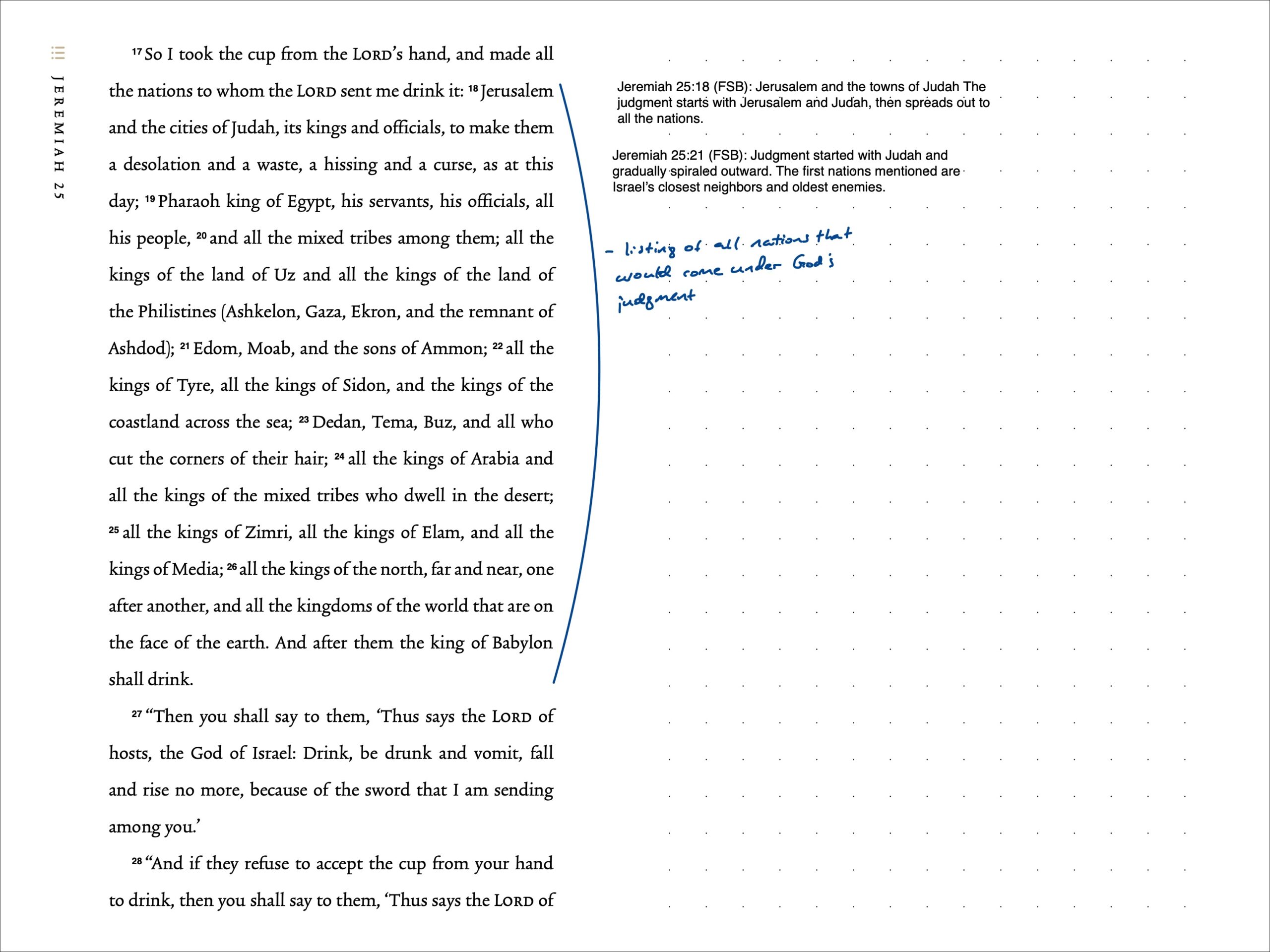| Date | Version | Reading Plan |
|---|---|---|
| @July 17, 2023 | ESV (2016) | ESV Prophets Plan 2023 |
Pericopes
- Seventy Years of Captivity
- The Cup of the Lord’s Wrath
Notes
The chapter opens with a word from the Lord to the people “in the fourth year of Jehoiakim the son of Josiah, king of Judah”. This is likely a reference to the accession year of Nebuchadnezzar in 605 BC.
In Jer. 25:3, Jeremiah speaks of how he had prophesied faithfully for 23 years but the people had not listened. He persistently spoke on the Lord’s behalf, telling them to “Turn now, every one of you, from his evil way and evil deeds” (Jer. 25:5). They were told to not go after other gods, provoking the Lord’s anger with the work of their hands (Jer. 25:6).
The consequence of their unfaithfulness comes in Jer. 25:8, where the Lord will “send for all the tribes of the north” and “for Nebuchadnezzar the king of Babylon” (Jer. 25:9). God sent for them Himself, denoting his direct will to use them for the judgment of the people. The destruction is compounded in Jer. 25:10 with the banishment of peace and prosperity from among them.
In Jer. 24:11, the Lord declares that they will go into Babylonian exile for 70 years. After this time, God will redirect His judgment on to Babylon itself, “making it an everlasting waste” (Jer. 25:12)
In Jer. 25:15, Jeremiah is instructed by the Lord to make the nations drink His cup of wrath. The cup of the wine of wrath is a common biblical image indicating God’s wrath (Jer. 49:12; Jer.51:7; Ps 60:3; Isaiah 51:17, 22; Ezek. 23:31; Hab. 2:16; Rev. 14:8, 10; Rev. 16:19; Rev. 18:6). The prophet did not physically take the cup to all the nations, but all nations would experience that cup in the tragedies of the future.
In Jer. 17-26, the nations that were to be made to drink of the cup of wrath are listed. The listing begins with Jerusalem and gradually spirals outward to “all the kings of the world that are on the face of the earth.” (Jer. 25:26). Jeremiah’s role in symbolically bringing the cup to all nations fulfills his commission to be the “prophet to the nations” (Jer. 1:5).
In Jer. 25:28, the Lord tells Jeremiah that refusal to drink the cup is not an option. There was no option of escape or go unpunished; they will either drink the cup or….they will drink it.
In Jer. 35:30-33, Jeremiah continues his prophesy to the people of the Lord’s wrath. God is imaged 1) as a lion who will “roar from on high” (Jer. 25:30), 2) like “those who tread out grapes” (Jer. 25:30) and 2) as a tempest (or storm) (Jer. 25:32). God’s judgment will encompass the nations and those who die “shall not be lamented, or gathered, or buried” (Jer. 25:33).
In the remaining verses (Jer. 25:34-38), God addresses the shepherds of the people, telling them to “cry out, and roll in ashes” (Jer. 24:34). Shepherds are mentioned 3x before switching over to describe the impending disaster of the nations. They will be shattered like a precious vase by the one who is Lord over all the earth.
Application
There are many things going on this chapter, but it was God’s precision in the use of a 70 year devastation that seemed noteworthy in today’s reading. Why 70 years? What makes that the ideal time frame? I can only speculate that this length of time would be long enough to bring about the intended correction but not so long as to wipe out the people completely.
God knows exactly where and how to turn the disciplinary dials to bring about an outcome that maximizes His glory. This may seem manipulative of cruel to our finite ears, but our thoughts must remain anchored to the truth of God’s goodness in sovereignty. There is a result toward which He is working and of which we are limited in our understanding. Praise be to God for the benevolence and trustworthiness of His mighty hands.
Scripture Journal Notes
Commentaries & Resources Used
- ESV Study Bible. (Wheaton, IL: Crossway, 2008)
- Faithlife Study Bible (Lexham Press, 2016)
- Believer’s Bible Commentary (Thomas Nelson, 2016)
- CSB Study Bible Notes (Holman Bible Publishers, 2017)
- Matthew Henry’s Commentary on the Whole Bible (Guardian Press, 1976)
- The Bible: A Reader’s Guide (Sterling Publishing, 2011)
- The Infographic Bible (Zondervan, 2018)
- ESV Digital Scripture Journal (Crossway, 2019)




